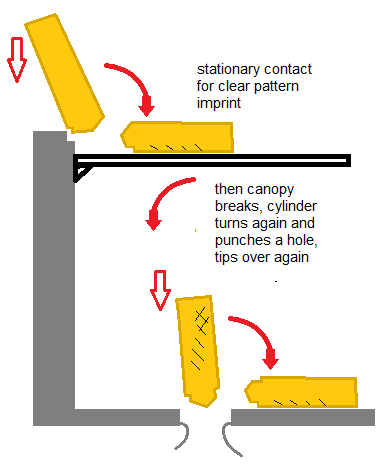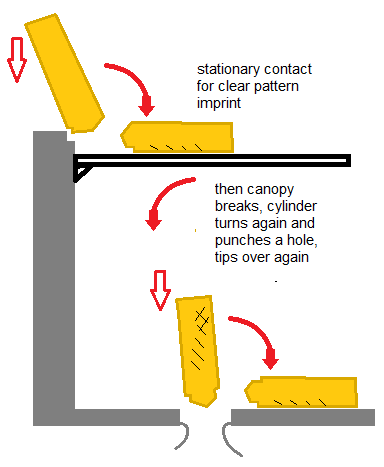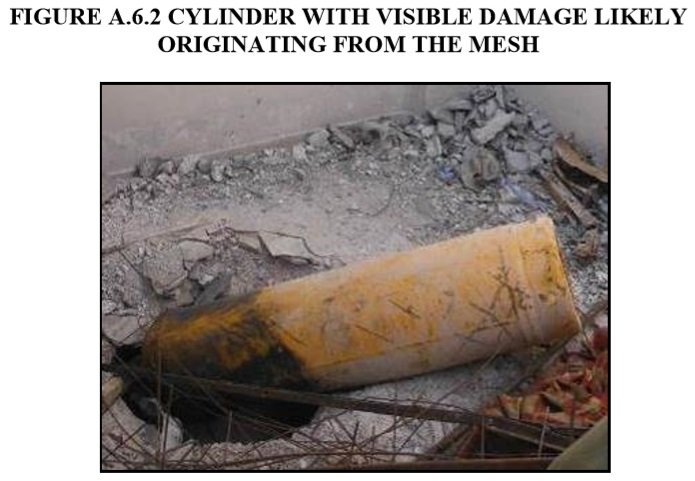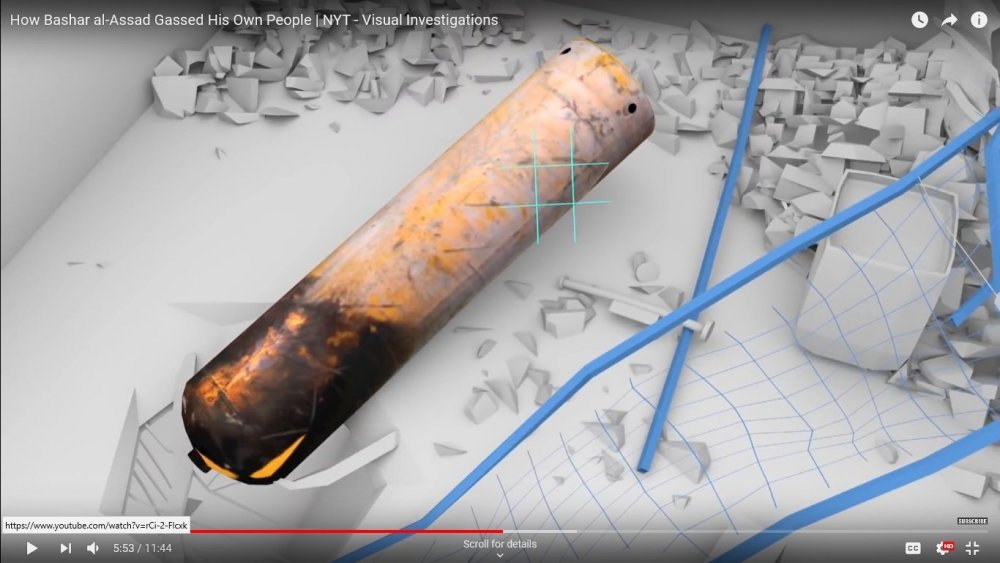

Adam Larson CL
Members-
Posts
7 -
Joined
-
Last visited
Content Type
Profiles
Forums
Events
Everything posted by Adam Larson CL
-

A question about falling bodies and impacts
Adam Larson CL replied to Adam Larson CL's topic in Physics
Hi, Michael! I was about to come back and bump this, hoping for more thoughts from the existing community. But this couldn't hurt in that, and it's another thought in this science-based discussion. Concerning the idea quoted below (I can't type below it), you don't see it at possible to hit the lattice (as needed) in between its nose-down impacts? That seems all but required for the scenaio. Does anyone else have a thought on this? What might be useful is a best effort to explain such an impact - it's not impossible, so what factors would make it possible enough to just happen? -

A question about falling bodies and impacts
Adam Larson CL replied to Adam Larson CL's topic in Physics
Best explanation to make it fit - not entirely specified. Chipped corner, (attached, w/some context reveal), then canopy something (no one's certain where it would anchor), the clear side imprint something, final hole punch and tip over something. It's all a bit mumbly, IMO, but I'm trying here. Canopy imprint is the current idea I'm tracing and assessing. The required movements and plausibility thereof. All the related parts are physics interesting too, and I'm happy to discuss it all. I just don't want to go off... "Was there an explosion at some point? It looks like there are burn marks." Some thought so, but ... officially no, in the proposed scenario. The fire inside is different - a lit fire, reason unclear. Otherwise, opinions differ. That is some bent rebar. But then as they point out, that intact bit could be where and why the cylinder stopped. "Do you even know when the marks were made? " The grid-like marks? I think they were scratched before the fire was lit, from the way its soot seems to catch extra on the lines there. Apparently then before it was moved around that we know of. Logically, it got the marks in the course of arriving at that spot. And opinions differ on how it got there. Some say it was placed by hand, next to unrelated explosives damage. Others say it fell from the air, though they don't say how it began falling. "Implausible isn't the same as impossible. You can flip a coin and have it come to rest on its edge. It's implausible for any one toss, but it happens." If it's remotely comparable to that ... I'm feeling vindicated in my doubts. Some people have been like "well, of course," and some competent expert proposed the idea. And maybe so, but ... maybe not their best call. but no one can illustrate it, so I had to make that image as a best guess or start point at one. -

A question about falling bodies and impacts
Adam Larson CL replied to Adam Larson CL's topic in Physics
A good number of variables, yes - not a simple one to be certain of. It would shift on first hit, maybe even to flip 90 degrees - which would mean its main velocity is done, tumbled away in side directions, not the best to continue to the next damage. That always was best seen as hit then hit on a pretty straight line. But maybe not. Other canopty positions: probably none but attached or on the floor could offer enough resistance. Or against a wall, and hits the wall, sideways? so if it punches through sideways, canopy attached as shown, it has to re-orient with no forceful sliding. It could hit straight, bounce back a little, then slide lightly... that's from clarity of the pattern - photo attached (and I don't think it's from full-grid contact anyway - just 2-3 loose bar ends scraping parallel lines when someone moved it - but I'm going with IF SO, then...) The final impact was calculated to be around 30 m/s to explain its not quite punching through. FWIW I don't think it explains the interior damage very well, as if no single speed can explain all of it. But this damage and the cylinder lying there are the two things considered to decided ~30 m/s, and roughly nose-first. So … ruling things in or out entirely isn't needed. The standard I'm curious about - and no rush getting there - is if the side-impact into the mesh is the kind of plausible thing a professional ballistics expert would propose to help prove that it was in fact falling - not as just hypothetically possible but as a matter of reasonable course (is that a phrase?). This is working - test it out a bit in a science context to see if it starts to make more sense or continues to seem pretty implausible. cheers -

A question about falling bodies and impacts
Adam Larson CL replied to Adam Larson CL's topic in Physics
Thanks! I wasn't sure if I'd get any bites ever, so this is good. I don't suppose more info is needed for the core question, but they're available. The imprinting isn't the issue so much as the sideways movement needed (I think) to make the imprint on the SIDE of a cylinder that's otherwise falling nose-down (+/- a few degrees) with some velocity. A key detail is the clarity of the grid imprint suggests no sliding across, just pressed straight into it. Yet its nose is hitting things right before that and right after that. And there are other possible arrangements for the canopy - set against a wall, torn down in crumpled pile, unclear. But I can't visualize anywhere the cylinder should hit it that way except if it's on the floor and the cylinder tips over forcefully onto it for the final move. What do you think T? Can you think of and describe a scenario that would allow this within the laws of physics? I'm hoping to rule it out, but only after really trying to make it (actually, physically) work. -
Anyone able to help me understand if this makes sense? A scenario someone proposed and I have reservations about. A gas cylinder - fill estimated ~170L compressed gas, plus steel cylinder + aerial harness (unclear weight) - is falling. Let's say it hits the upper corner at ~50 m/s, and slows to 30 m/s before hitting the balcony floor. Not shown: the aerial harness with fins are on at first but removed somewhere on the way, left badly crumpled. It's designed so the thing falls nose/valve first. Both the corner impact and subsequent impact through the balcony floor are presumed nose-first, but not necessarily 100% vertical. Then somehow its falling causes THE SIDE of the cylinder to impact onto this wire mesh canopy frame, somehow imprinting its clear grid pattern in the paint. We're not sure if the canopy was still erected, or torn down already, maybe crumpled in a corner as seen later. The latter would leave many possible impact angles, most of which would be lower and at weirder angles than this, and with a less rigid grid offering almost no resistance. Anyway, it flips or angles or whatever into the mesh but not along it, then it's mostly nose-down (again or still?) and does its bizarre move to punch a serious hole in the concrete but then doesn't fall through it. That last step is also problematic, but it's the mesh impact I need to pin down. As I reason, the movement would have to be sideways so the lateral aspect of the cylinder did not slide on the mesh but it hit perpendicularly. Is there or is there not any plausible way to have a lateral move into the mesh - with no sliding against it - during or in-between nose-down positions at the given speeds (again ranging from 50-30 m/s) with an object that heavy? Sorry to be the lame science parasite here. I respect science, but never mustered the mustard OR patience to learn the right formulas and apply calculations. I also know amateurs can do it wrong and get useless results. And here we could really use a solid view, not me stumbling around. I'll check back regularly. more details/explanations available if it helps. Thanks! - Adam
-

OPCW Douma probe: a ballistics/engineering/physics question
Adam Larson CL replied to Adam Larson CL's topic in Politics
Thanks for the tips. I'd rather leave the politics out, but didn't want to be accused of being a SNEAKY "Russian troll." It's made extra hard for us. And I wondered if the url was allowed. I thought more information would help anyone thinking of answering, or maybe they'd want to see the context it would go in. But if anyone asks, I can find a non-compiled source and re-create my notes as needed. FFM report + NYT links are good to start. And should I also take this sans explanation and no "advertising" to the … not this forum? -
Hi! I'm one of those "Russian disinformation" "conspiracy theory" people you've heard about. I could debate the issues and defend my OWN and honestly derived findings and views as needed, start a general thread on it, etc. In due time. But for now, I have just one question that SHOULD be simple and scientific. But unfortunately it's been politicized so that many people won't even want to touch it. Since the politics affects the science or discussion of it, both might come up and it seems politics section of Science Forums is the place. Syria, Douma, 7 April 2018, deadly chlorine attack, the leaks and whistleblowers of the least year, and OPCW losing some credibility because of Russian lies or because their Fact-Finding Mission's biased methods in the Douma probe have been exposed (opinions differ.) The point (I'll try and upload the image I made for this. ) This one point isn't central, but was accepted as a solid clue for aerial delivery by several influential people including the New York Times (with Forensic Architecture and Bellingcat) (see 5:50 in this video https://www.youtube.com/watch?v=P2X84JZINcI ... and the OPCW's Fact-Finding Mission in their final report. (see page 54 here for how it was presented: https://www.opcw.org/sites/default/files/documents/2019/03/s-1731-2019(e).pdf and attached fig. A.6.2) But it seems downright absurd to me and everyone I ask. So apparently opinions differ, and that's not the right way to approach it. A chlorine gas cylinder - fill estimated ~170L compressed gas, plus steel cylinder + aerial harness (unclear weight) - is falling. The FFM concludes it hits this upper corner at ~50 m/s, and slows to 30 m/s before hitting the balcony floor. Not shown: the aerial harness with fins thought to be on at first but removed somewhere on the way, left badly crumpled. It's designed so the thing falls nose/valve first. Both the corner impact and subsequent impact through the balcony floor were presumed nose-first. Then somehow its falling causes THE SIDE of the cylinder to impact onto this wire mesh canopy frame, somehow imprinting its clear grid pattern in the paint (figure A.6.2 attached shows the marks and the mesh - the proportions do seem to match - see FA modeling, attached). The FFM wasn't sure if the canopy was still erected, or torn down already, maybe crumpled in a corner as seen later. The latter would leave many possible impact angles, most of which would be lower and at weirder angles than this, and with a less rigid grid offering almost no resistance. Anyway, it flips or angles or whatever into the mesh but not along it, then it's mostly nose-down (again or still?) and does its bizarre move to punch a serious hole in the concrete but then doesn't fall through it. That last step is also problematic, but it's the mesh impact I need to pin down. As I reason, the movement would have to be sideways; the FFM is clear "the lateral aspect of the cylinder did not slide on the mesh but it hit perpendicularly." Is there or is there not any plausible way to have a lateral move into the mesh - with no sliding against it - during or in-between nose-down positions at the given speeds (again ranging from 50-30 m/s) with an object that heavy? None of those involved in promoting this idea (Bellingcat, Forensic Architecture, the New York Times, the FFM) have visually illustrated their proposed impact, on their own or at my urging. They show the marks line up, but not how they were formed. It leaves us guessing, and that image is my guess. Anyone here see it their way and willing to try and explain it to me? Or anyone here see it like I do and willing to help me correct the record? Especially helpful: anyone the masses would consider extra-credible, a professor with a PhD and military experience, for example, who can also give a cogent explanation. I'd like to add it to my blog post on the subject, alongside tracing the FFM's possible source for the idea, and my own speculation about these marks and what they mean. URL deleted Sorry to be the lame science parasite here. I respect science, but never mustered the mustard OR patience to learn the right formulas and apply calculations. I also know amateurs can do it wrong and get useless results. And here we could really use a solid view, not me stumbling around. I'll check back regularly. Thanks! - Adam







